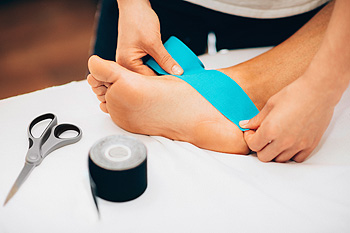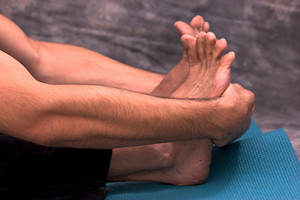Items filtered by date: July 2019
How to Treat Wounds on the Feet
 The feet are susceptible to cuts that may penetrate the skin. Minor wounds can be treated with bandages or skin glue, and the healing process will accelerate if the cuts are kept covered and dry. If you have stepped on glass or rocks, an X-ray may be necessary to ensure there is no debris left in the foot. For serious wounds, it is beneficial to keep weight off of the foot as much as possible, as this can help in giving the foot a chance to heal. If the wound is bleeding, it is helpful to apply direct pressure. If this fails to work, it is wise to seek medical attention. Additionally, an infection may be present which is often accompanied by a fever. For wounds on the feet, it is suggested to seek the counsel of a podiatrist who can guide you towards proper treatment.
The feet are susceptible to cuts that may penetrate the skin. Minor wounds can be treated with bandages or skin glue, and the healing process will accelerate if the cuts are kept covered and dry. If you have stepped on glass or rocks, an X-ray may be necessary to ensure there is no debris left in the foot. For serious wounds, it is beneficial to keep weight off of the foot as much as possible, as this can help in giving the foot a chance to heal. If the wound is bleeding, it is helpful to apply direct pressure. If this fails to work, it is wise to seek medical attention. Additionally, an infection may be present which is often accompanied by a fever. For wounds on the feet, it is suggested to seek the counsel of a podiatrist who can guide you towards proper treatment.
Wound care is an important part in dealing with diabetes. If you have diabetes and a foot wound or would like more information about wound care for diabetics, consult with Jim Maxka, DPM from South Penn Foot & Ankle Associates. Our doctor will assess your condition and provide you with quality foot and ankle treatment.
What Is Wound Care?
Wound care is the practice of taking proper care of a wound. This can range from the smallest to the largest of wounds. While everyone can benefit from proper wound care, it is much more important for diabetics. Diabetics often suffer from poor blood circulation which causes wounds to heal much slower than they would in a non-diabetic.
What Is the Importance of Wound Care?
While it may not seem apparent with small ulcers on the foot, for diabetics, any size ulcer can become infected. Diabetics often also suffer from neuropathy, or nerve loss. This means they might not even feel when they have an ulcer on their foot. If the wound becomes severely infected, amputation may be necessary. Therefore, it is of the upmost importance to properly care for any and all foot wounds.
How to Care for Wounds
The best way to care for foot wounds is to prevent them. For diabetics, this means daily inspections of the feet for any signs of abnormalities or ulcers. It is also recommended to see a podiatrist several times a year for a foot inspection. If you do have an ulcer, run the wound under water to clear dirt from the wound; then apply antibiotic ointment to the wound and cover with a bandage. Bandages should be changed daily and keeping pressure off the wound is smart. It is advised to see a podiatrist, who can keep an eye on it.
If you have any questions, please feel free to contact our office located in Hanover, PA . We offer the newest diagnostic and treatment technologies for all your foot care needs.
How to Stretch Your Feet
Your feet endure a great amount of stress each day from constantly allowing us to move around. It is important to stretch your feet to help prevent them from becoming injured. Your toes may easily deform into unhealthful positions if they are not stretched.
One of the most common reasons for toe deformities are the shoes you may be wearing. Shoes that are too tight may fold and shift the toes out of place. Heeled shoes may also push your toes upward. Forcing your toes into an unnatural position which may cause the muscles to tighten and prevent them from reverting to normal length. Another common reason is improper use of foot muscles. Many people fail to use the muscles in their feet or toes when they walk. Lastly, the positioning of your feet while walking may also cause toe deformities. If you walk with your feet facing outward, your “push-off” phase is on the side of your big toe instead of the bottom of your foot. This may cause the big toe to eventually tighten into a new shifted position.
There are many reasons why stretching your toes may be helpful. One reason is that healthy spacing may aid in avoiding calluses and other injuries that are caused by rubbing. Stretching will also prevent you from developing toes that curl, hammertoes, or bunions.
A great way to stretch your toes is to place them in your hands and bend them all downward; this will help you stretch the top of your foot. Next, you should repeat this process but instead bend them upward enough to feel a nice stretch in the bottom of your foot. You should then try to pull each toe apart from the next and pull any toes that are bent upward until they are back downward.
If you are looking to practice stretching your entire foot, you can try a towel stretch. This is done by sitting on the floor with your legs in front of you. Take a towel and wrap it around your toes. Afterward, pull the towel toward you with your toes and hold this position for 15 to 30 seconds before releasing. Practice this stretch for three sets. Another stretch your feet are towel lifts. This is done by sitting in a chair and trying to pick a towel up from the ground with your toes. Try lifting the towel with your little toes for five sets before switching feet.
If you are an athlete, or exercise often, it is especially important for you to practice stretching your feet. Those who suffer from foot pain caused by poor footwear, plantar fasciitis, or long hours of standing at work may also benefit from foot exercises.
Stretching the Calf Muscles May Help the Feet
 Tight calf muscles can lead to uncomfortable foot conditions that include plantar fasciitis, bunions, and tendinitis. There are reasons why calf muscles may be shortened, including genetic factors, wearing high heels for the majority of the day, or problems with posture. When the calf muscles are properly stretched, walking and running activities will typically become easier to perform. An effective calf stretch is done by standing on a step while letting the heel of one foot dip, and then repeating on the other foot. This is helpful in lengthening the Achilles tendon. Those patients who are interested in yoga can perform a downward dog yoga stretch. This is done by placing the hands on the floor, and lifting up and down on the toes. If you would like additional information about the benefits of stretching feet, please consult with a podiatrist.
Tight calf muscles can lead to uncomfortable foot conditions that include plantar fasciitis, bunions, and tendinitis. There are reasons why calf muscles may be shortened, including genetic factors, wearing high heels for the majority of the day, or problems with posture. When the calf muscles are properly stretched, walking and running activities will typically become easier to perform. An effective calf stretch is done by standing on a step while letting the heel of one foot dip, and then repeating on the other foot. This is helpful in lengthening the Achilles tendon. Those patients who are interested in yoga can perform a downward dog yoga stretch. This is done by placing the hands on the floor, and lifting up and down on the toes. If you would like additional information about the benefits of stretching feet, please consult with a podiatrist.
Stretching the feet is a great way to prevent injuries. If you have any concerns with your feet consult with Jim Maxka, DPM from South Penn Foot & Ankle Associates. Our doctor will assess your condition and provide you with quality foot and ankle treatment.
Stretching the Feet
Being the backbone of the body, the feet carry your entire weight and can easily become overexerted, causing cramps and pain. As with any body part, stretching your feet can serve many benefits. From increasing flexibility to even providing some pain relief, be sure to give your feet a stretch from time to time. This is especially important for athletes or anyone performing aerobic exercises, but anyone experiencing foot pain or is on their feet constantly should also engage in this practice.
Great ways to stretch your feet:
- Crossing one leg over the others and carefully pull your toes back. Do 10-20 repetitions and repeat the process for each foot
- Face a wall with your arms out and hands flat against the wall. Step back with one foot and keep it flat on the floor while moving the other leg forward. Lean towards the wall until you feel a stretch. Hold for 30 seconds and perform 10 repetitions for each foot
- Be sure not to overextend or push your limbs too hard or you could risk pulling or straining your muscle
Individuals who tend to their feet by regular stretching every day should be able to minimize foot pain and prevent new problems from arising.
If you have any questions, please feel free to contact our office located in Hanover, PA . We offer the newest diagnostic and treatment technologies for all your foot care needs.
